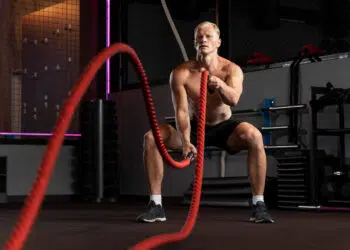Not so many years ago, cardio meant going for a jog. Jogging was how millions if not billions of people kept fit and lost weight. It was the jogging phenomenon that gave us mass-participation marathons and fun runs.
More recently, when someone talks about cardio, they are probably talking about high-intensity interval training, or HIIT for short. HIIT is very much a fitness industry buzzword.
These two effective training approaches are at opposite ends of the intensity spectrum, and a lot of people are drawn toward shorter, more intense interval workouts. Jogging and other forms of lower-intensity cardio are often viewed as old-fashioned and inefficient.
However, while HIIT is a sexy acronym, and things like ultra-intense Tabata workouts undoubtedly have their appeal, low-intensity steady-state cardio activities like jogging, cycling, and swimming are still valuable and, in some cases, may even be preferable to vomit-inducing HIIT workouts.
In this article, we delve into the pros and cons of steady-state cardio and explain why it still deserves to be part of your workouts.
Interval Training vs. Steady State Cardio Basics
Before we look at the pros and cons of steady-state cardio, let’s take a moment to define these two very different types of cardio.
Level Up Your Fitness: Join our 💪 strong community in Fitness Volt Newsletter. Get daily inspiration, expert-backed workouts, nutrition tips, the latest in strength sports, and the support you need to reach your goals. Subscribe for free!
Interval training
Involves short bursts of activity broken up with brief rests. For example, you could cycle fast for 60 seconds, go slow for another 60 seconds, and then repeat ten times to total 20 minutes.
There are lots of ways to do interval training, and the length of the work and rest periods depend on your training goal and fitness levels. For example, alternating jogging and walking is a form of interval training, as is sprinting and then standing still to recover. Needless to say, the shorter the work period, the more intense the workout will probably be.
As well as work and rest period variations, interval training can involve lots of different training modalities. Standard cardio options like cycling, running, and rowing work well, but you can also do intervals using bodyweight, kettlebell, barbell, and dumbbell exercises.
Interval workouts are usually shorter than steady-state cardio workouts, but they tend to burn more calories per minute because the intensity is higher. In studies, interval training has been shown to have a significant impact on cardiorespiratory fitness, measured in terms of V02 max. It’s also been shown to be an effective training method for fat loss and weight control (1).
Interval training is also known for its afterburn effect, more properly called Excess post-oxygen oxygen consumption, or EPOC for short. 30 minutes of interval training burns about 7% more calories after the cessation of exercise than 30 minutes of steady-state cardio (2).
Related: Three Common Interval Training Mistakes You Might be Making
Steady-state cardio
Involves exercising for a prolonged period at a lower level of intensity, usually between 60-90% of maximum heart rate. Good training activities for steady-state cardio include running, cycling, swimming, rowing, cross-country skiing, paddleboarding, and kayaking.
Because steady-state cardio is usually done at a low to moderate intensity, workouts tend to be longer – anywhere from 20 minutes to 60 minutes or more. However, the defining characteristic of steady-state cardio is that the intensity level remains relatively unchanged for the duration of the workout.
While steady-state cardio tends to burn fewer calories per minute than interval training, this benefit is largely negated because most people can exercise for longer. Like interval training, steady-state cardio has significant cardiovascular fitness benefits (1).
Steady-State Cardio – Pros
There is no denying the popularity and effectiveness of interval training. Workouts are more time-efficient and, despite being shorter, can help burn fat and keep it off. It also replicates the start-stop demands of most team sports, so it’s popular with and useful for athletes too.
That said, steady-state cardio has some notable benefits, which is why it will always be a valuable form of training.
The pros of steady-state cardio training include:
Better cardiovascular health
Cardiovascular health refers to the condition of your heart, lungs, and circulatory system. Steady-state cardio has been shown to provide protection against coronary heart disease, heart attacks, and strokes. It can help lower blood pressure, reduce levels of bad LDL cholesterol and triglycerides, and raise good HDL cholesterol (3).
Better muscular endurance
Endurance is your ability to generate low amounts of force for extended periods. While steady-state cardio does involve your heart and lungs, it also targets your slow-twitch muscle fibers, which are responsible for endurance. Better endurance means you’ll be more resistant to fatigue and recovery faster between bouts of physical activity.
Related: What is Muscular Endurance and exercises to improve it
Less joint stress
Sprints, burpees, box jumps, and other high-intensity interval training methods can be hard on your joints. That goes double if you are a beginner or overweight. While some steady-state cardio activities are high-impact, there are plenty of low-impact, joint-friendly options too. Plus, because you’ll be working at a slower pace, the stress on your body is likely to be lower.
Level Up Your Fitness: Join our 💪 strong community in Fitness Volt Newsletter. Get daily inspiration, expert-backed workouts, nutrition tips, the latest in strength sports, and the support you need to reach your goals. Subscribe for free!
More frequent workouts
High-intensity interval training can be exhausting, and if it’s not, you probably aren’t working hard enough! As such, you probably won’t feel like working out several days in a row. Rest days are all but unavoidable. In contrast, and especially if you rotate training methods, you can do steady-state cardio pretty much every day if you so wish. In theory, this could lead to more significant weight loss.
More enjoyment
While some exercisers love the challenge of interval training, others find it uncomfortable and unenjoyable. For any workout to be effective, you need to do it frequently and consistently. If you dread your training program, even if it is effective, you are more likely to skip workouts, negating any potential benefits. Exercise scientists rate exercise enjoyment using the EES or Exercise Enjoyment Score, and in studies, steady-state cardio often scores higher than interval training (4).
Effective for weight loss
Even though interval training burns more calories per minute, steady-state cardio has also been shown to be an effective weight-loss method (5). Steady-state cardio burns an average of 100 calories per ten minutes which, if done for 30 minutes a day, five days a week, will soon add up and enhance weight loss.
Tip: Calories Burned Calculator By Exercises, Select Over 250 Exercises!
Enhanced recovery
Steady-state cardio is a helpful recovery tool. It enhances the removal of metabolic waste products from muscle tissue and floods those muscles with freshly oxygenated blood and nutrients. Providing the intensity is kept low, an easy, steady-state cardio workout between intense training days could allow for more complete recovery and better training progress. High-intensity interval workouts would not have the same restorative effect. In fact, they’d only cause more fatigue.
Better for beginners
Because of the popularity of HIIT, a lot of beginners are drawn toward workouts that they really aren’t fit enough to do safely. Most beginners would do better if they built their basic fitness with steady-state cardio before progressing to high-intensity workouts.
Good for your mental health
While all types of exercise are good for your mental health, steady-state cardio is arguably one of the best. With little else to think about other than putting one foot in front of the other, steady-state cardio is almost a form of moving meditation. Studies have shown that steady-state cardio can help prevent and treat several mental health issues, including depression (6).
Steady-State Cardio – Cons
It’s pretty clear that steady-state cardio can be very beneficial and rewarding. However, it’s not without drawbacks. The main cons of steady-state cardio are:
Time-consuming
A high-intensity interval training workout can be over and done in as little as four minutes. In contrast, for steady-state cardio to be effective, you need to do at least 20 minutes, and a lot of exercisers do much more than this. Getting fit and losing weight using steady-state cardio requires a significant time investment. According to the American Heart Association, to enjoy the benefits of steady-state cardio, you need to clock up around 150 minutes per week.
Risk of overuse injuries
Doing the same activity over and over can cause localized inflammation, joint pain, and other overuse injuries. These issues are so common that they have names linking them to certain activities, such as runner’s knee and swimmer’s shoulder. These issues are mainly chronic, which means they develop and worsen over time. One way around this is to vary your workouts and use different exercise modalities, such as running one day, cycling the next, and swimming the day after that.
It can be boring
Regular long duration steady-state cardio workouts can become tedious, especially if you do the same thing every day, e.g., jogging 5k. Avoid boredom by changing your cardio activities, following different routes, working out with a friend, or listening to music or audiobooks.
Fitness and weight loss may plateau
If you always do what you’ve always done, you’ll always get what you always got! In other words, to keep getting fitter and continue losing weight, your workouts must be progressive, and that includes cardio. If you always do the same workout at the same speed, you won’t get any fitter. Modify your workouts to ensure you keep challenging your body. Increase duration, intensity, and frequency to maintain your progress.
Won’t do much for strength or power
While steady-state cardio is excellent for improving muscular endurance, it won’t do much for strength or power. Low-intensity workouts have very little effect on your fast-twitch muscle fibers. So, if you want to be fit AND strong, you need to combine steady-state cardio with strength training. In contrast, many HIIT workouts work those fast-twitch fibers by default.
Steady State Cardio – Wrapping Up
We’ve got steady-state cardio in the red corner, and in the blue corner, there’s interval training. But which one is our winner?
Each one has advantages, and each one has drawbacks too. For example, interval training burns more calories per minute and triggers a more significant afterburn effect. But steady-state cardio workouts last longer, and you can probably do them more often.
Ultimately both types of cardio are effective and can help you get fit, lean, and healthy. Remember, too, that weight loss is as much about diet as exercise, so neither of these training methods will help you shed that unwanted fat unless you are eating healthily.
Which one should you choose? Maybe, you don’t need to choose at all, and should do them both? Or base your choice on which one you enjoy the most and are more likely to do consistently.
Either way, you need cardio as part of your workouts. There is no point having cannonball delts or wing-like lats if your heart is small and weak, or you need five minutes to get your breath back after a set of squats! A couple of cardio workouts per week will have a significant impact on how you look, feel, and perform.
References:
1 – PubMed: The Effects of High-Intensity Interval Training vs. Steady State Training on Aerobic and Anaerobic Capacity (source)
2 – PubMed: Effect of An Acute Period of Resistance Exercise on Excess Post-Exercise Oxygen Consumption: Implications for Body Mass Management (source)
3 – American Heart Association: American Heart Association Recommendations for Physical Activity in Adults and Kids (source)
4 – PubMed: Relationship Between Objectively Measured Intensity of Physical Activity and Self-Reported Enjoyment of Physical Activity (source)
5 – The Obesity Society: Aerobic Exercise Alone Results in Clinically Significant Weight Loss for Men and Women (source)
6 – British Journal of Sports Medicine: Benefits from Aerobic Exercise in Patients with Major Depression: A Pilot Study (source)













